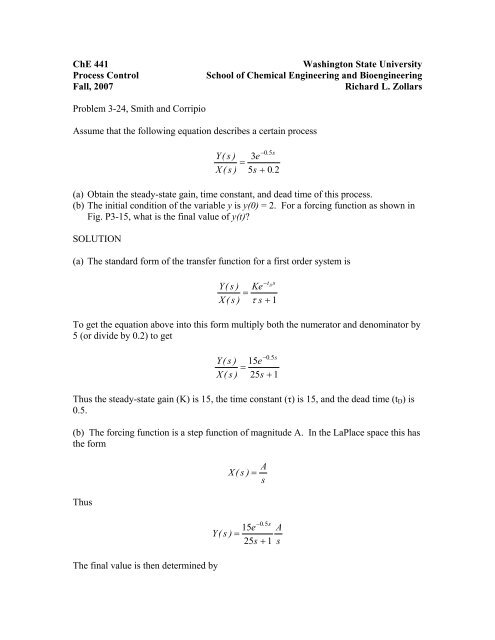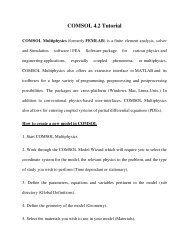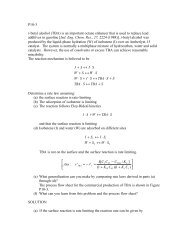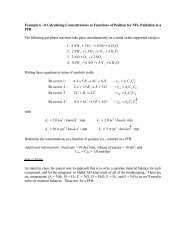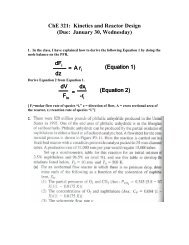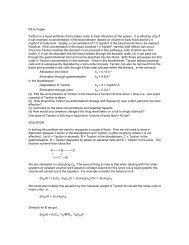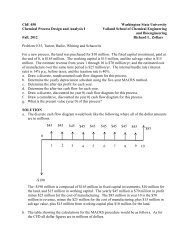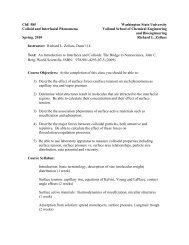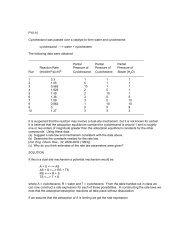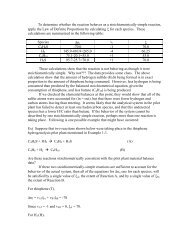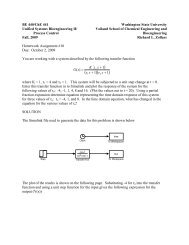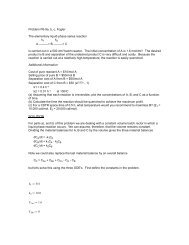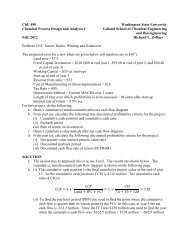ChE 441 Washington State University Process Control School of ...
ChE 441 Washington State University Process Control School of ...
ChE 441 Washington State University Process Control School of ...
You also want an ePaper? Increase the reach of your titles
YUMPU automatically turns print PDFs into web optimized ePapers that Google loves.
<strong>ChE</strong> <strong>441</strong><br />
<strong>Process</strong> <strong>Control</strong><br />
Fall, 2007<br />
<strong>Washington</strong> <strong>State</strong> <strong>University</strong><br />
<strong>School</strong> <strong>of</strong> Chemical Engineering and Bioengineering<br />
Richard L. Zollars<br />
Problem 3-24, Smith and Corripio<br />
Assume that the following equation describes a certain process<br />
Y( s )<br />
X( s )<br />
−0.<br />
5s<br />
3e<br />
=<br />
5s<br />
+ 0.<br />
2<br />
(a) Obtain the steady-state gain, time constant, and dead time <strong>of</strong> this process.<br />
(b) The initial condition <strong>of</strong> the variable y is y(0) = 2. For a forcing function as shown in<br />
Fig. P3-15, what is the final value <strong>of</strong> y(t)?<br />
SOLUTION<br />
(a) The standard form <strong>of</strong> the transfer function for a first order system is<br />
Y( s )<br />
X( s )<br />
−t D<br />
s<br />
Ke<br />
=<br />
τ s + 1<br />
To get the equation above into this form multiply both the numerator and denominator by<br />
5 (or divide by 0.2) to get<br />
Y( s )<br />
X( s )<br />
−0.<br />
5s<br />
15e<br />
=<br />
25s<br />
+ 1<br />
Thus the steady-state gain (K) is 15, the time constant (τ) is 15, and the dead time (t D ) is<br />
0.5.<br />
(b) The forcing function is a step function <strong>of</strong> magnitude A. In the LaPlace space this has<br />
the form<br />
Thus<br />
The final value is then determined by<br />
Y( s )<br />
X ( s ) =<br />
A<br />
s<br />
−0.<br />
5s<br />
15e<br />
=<br />
25s<br />
+ 1<br />
A<br />
s
⎡<br />
−0.<br />
5s<br />
15e<br />
y( ∞ ) = lim [ sY( s )] = lim⎢s<br />
s→0<br />
s→0<br />
⎣ 25s<br />
+ 1<br />
A⎤<br />
⎥ = 15A<br />
s ⎦<br />
This should be a deviation variable, however. To find the real value we need to add the<br />
prior steady-state. Thus the true final value <strong>of</strong> y(t) is 15A + 2.


